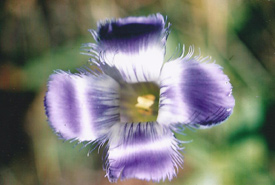How to be a botanist

One of the most beautiful of Happy Valley blooms is the fringed gentian flower. (Photo by Dr. Henry Barnett)
You may know from my previous posts that I consider myself an amateur botanist and spend time associating with several naturalist and conservation organizations, including the Nature Conservancy of Canada (NCC). I try to share my experience and knowledge whenever I can. In one case, someone asked a question on the Field Botanists of Ontario Facebook forum to which I responded with some recommendations of my own.
Question:
“What are the "must-have" resources for a botanist in Ontario? I haven't been doing this very long, but have really appreciated Newcomb's Wildflower Guide, Michigan Flora, Peterson’s Fern Guide, among others. I'd appreciate any and all recommendations, whether field guide, key, natural history…whatever.”
My response:
"Wow! I don't know how old you are, but I was in your position 10 years ago. Botany in Ontario as a subject area is broader than broad when expressing a general interest. Personally, early on I decided to restrict my botanical interest to the woody plants of Grey and Bruce Counties (approximately 175 species).
"At this point I have managed to find a new species never recorded before in this area (not nearly as exciting as finding a new one!) and I am currently preparing for local spring willow, serviceberry and hawthorn flowering treks; I go through short periods looking at different groups of plants. I must admit that in the 10 years, I have been distracted by fungi, wildflowers, sedges, the botanical history of this area, botanical taxonomy and so on. Still, my main satisfaction has come from knowing more about less (a select set of species).
"One way of discovering/focusing one's interest is to become a steward of a nature reserve (informal or otherwise). I became involved with NCC’s Cuzen property just south of Chatsworth. I obtained a plant list for the property and started from there. Actually all NCC properties generally have a flora and a fauna list!
"Of course, any nature reserve will or should have a plant list. This provides a wonderful way to focus one's efforts. You see something, attempt to identify it, see if it is on the list, talk to a biologist at NCC or wherever and so on. I found a pitcher plant on the Cuzen property for example, which was not on the list!
"Regarding resources, I would say to have a question first and then to look for the resource. Newcomb's Wildflower Guide, Shrubs of Ontario and Trees in Canada are the basics. If you are into kayaking/canoeing, I would have to add Wetland Plants of Ontario to that list. Peterson's A Field Guide to Trees and Shrubs has been very valuable to me over the years but only because of my specific interest in that area. You can also get a list of all plants found in Ontario from the Natural Heritage Information Centre.
"Every journey starts with the first step. Start with a question and go from there."


